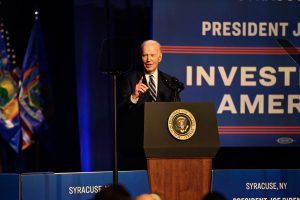Syracuse works to support individuals affected by disproportionate unemployment rates
Syracuse sees disproportionate unemployment rates

This March marks the one-year anniversary of COVID-19 hitting the U.S. As the coronavirus spread across the country, it violated people’s living standards and caused large layoffs as the economy experienced an unexpected and unprecedented recession.
This stark rise has caused some experts to view unemployment as a social problem. According to the U.S. Department of Labor, the number of Americans applying for unemployment benefits reached 770,000 in mid-March. Although the number dropped to 657,000 last week while vaccine distributions are helping lower infections, unemployment is still an issue nationally and at the county and city level in central New York.
In response to this, the city of Syracuse and a few local agencies are working together to provide support and alleviate the situation.
Deanna Cohen, deputy director of communications at the New York State Department of Labor, wrote in an email that the department “cannot speculate jobs or the economy.” The department does, however, release weekly reports on the unemployment situation based on industry, age, race, and ethnicity, which can partially reflect the short-term economic situation.
One of the evaluations focuses on Unemployment Insurance, which helps people who lose their jobs by temporarily replacing part of their wages while they look for work. Former President Donald Trump signed the Families First Coronavirus Response Act in March 2020, a law which provided additional flexibility for UI agencies and additional administrative funding to respond to the COVID-19 pandemic.
A year after Trump’s signature, the New York State Department of Labor reported that initial claims for UI increased by 231% over the past year — including out-of-state residents — in New York state for the week ending on March 13, and central New York increased by 285% compared with last year. Additionally, Onondaga County experienced an increase of 231% and received more than one thousand initial claims in the first week of March, according to the latest report from the New York State Department of Labor.
Jennifer Tifft, deputy commissioner at the Department of Neighborhood and Business Development of Syracuse, suggested that the city has been in a situation where it has a consistently high unemployment rate compared with that at the county level.
Data from the New York State Department of Labor illustrates Tifft’s claims. In the fiscal year of 2020, Syracuse experienced an annual unemployment rate of 11.37%, with a peak in April at 18.30% after the coronavirus hit its neighborhoods. Meanwhile, the county maintained an annual rate of 8.38%, peaking in April of 2020 at 16.10%.
Pandemic-caused layoffs are one of the main reasons for the high unemployment rate that has persisted since last April, according to Jen Lawrence, the employment manager at InterFaith Works of Central New York. Lawrence said she observed that casinos, restaurants and other hospitality services laid off the most workers, while the storage sector like warehouses maintained the normal level.
Although the higher unemployment rate could be explained by the pandemic and the comparatively larger population in Syracuse, Tifft pointed out that concerns about transportation, as well as family problems with children, stopped many workers from looking for a job, both before and during the pandemic.
Lawrence agreed with the concern on transportation and added that English is another major challenge for new Americans to find a job.
To solve these issues, InterFaith Works collaborated with other local non-profit organizations like the Providence Services of Syracuse to “transport people to work by picking them up at their house to work and then bringing them back,” Lawrence said.
Several other agencies, such as the Syracuse Educational Opportunity Center, also provided unemployed individuals with basic English training for jobs that require higher-level English skills, Lawrence added.
While the pandemic is ongoing, more than 379,000 jobs entered the market in February across the country. Workers in the Syracuse, however, still haven’t filled in the new job opportunities yet. Tifft thus highlighted another major concern among the workforce in Syracuse.
“There is a need for many local workers to upgrade their skillsets because more jobs recently require high-technology skills that they may be inadequately equipped,” Tifft said.
Because of this, the city, along with several local corporations, is working on training workforces for emerging new-economy sectors that are coming to the city. These include the information technology and drone industries, which are part of the Syracuse Surge project, Tifft added.
CenterState CEO — an independent economic development strategy and business leadership organization — is one of the partners that is working on labor networking and training. Marcus Webb, an economic inclusion fellow, works on the economic inclusion portfolio, specifically with community engagement.
Starting last July, the corporation launched a series of technical speaker events and has managed to bring in more than 11 diverse speakers to share their stories with over 300 attendees,
“These events focused on promoting diversity and inclusion in technology and highlight local and national professionals or entrepreneurs, which aims to help audience strengthen their belief of ‘I can do this,’” Webb said.
With many local residents participating in these talks, Webb and the team hope to bring more minorities to join the events so that more people with diverse backgrounds can build up their network and gain more opportunities in the future.
“(We’re) trying to make sure that we’re reaching out to individuals within the community and getting them equal opportunities here in Central New York,” Webb said.
Correction:
The number of people seeking unemployment benefits once exceeded 770,000 last year amid the pandemic. This factual error was removed from the story on March 26.





